
Tanzania comprises many lakes, national parks, and Africa's highest point, Mount Kilimanjaro. Northeast Tanzania is mountainous, while the central area is part of a large plateau covered in grasslands. The country also contains the southern portion of Lake Victoria on its northern border with Uganda and Kenya.
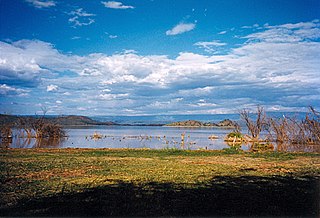
Lake Baringo is, after Lake Turkana, the most northern of the Kenyan Rift Valley lakes, with a surface area of 130 square kilometres (50 sq mi) and an elevation of 970 metres (3,180 ft). The lake is fed by several rivers: the Molo, Perkerra and Ol Arabel. It has no obvious outlet; the waters are assumed to seep through lake sediments into the faulted volcanic bedrock. It is one of the two freshwater lakes in the Rift Valley in Kenya, the other being Lake Naivasha.

Lake Victoria is one of the African Great Lakes. With a surface area of approximately 59,947 km2 (23,146 sq mi), Lake Victoria is Africa's largest lake by area, the world's largest tropical lake, and the world's second-largest fresh water lake by surface area after Lake Superior in North America. In terms of volume, Lake Victoria is the world's ninth-largest continental lake, containing about 2,424 km3 (1.965×109 acre⋅ft) of water. Lake Victoria occupies a shallow depression in Africa. The lake has an average depth of 40 m (130 ft) and a maximum depth of 80–81 m (262–266 ft). Its catchment area covers 169,858 km2 (65,583 sq mi). The lake has a shoreline of 7,142 km (4,438 mi) when digitized at the 1:25,000 level, with islands constituting 3.7% of this length.

The shoebill, also known as the whalebill, whale-headed stork, and shoe-billed stork, is a large long-legged wading bird. It derives its name from its enormous shoe-shaped bill. It has a somewhat stork-like overall form and has previously been classified with the storks in the order Ciconiiformes based on this morphology. However, genetic evidence places it with pelicans and herons in the Pelecaniformes. The adult is mainly grey while the juveniles are more brown. It lives in tropical East Africa in large swamps from South Sudan to Zambia.

Lungfish are freshwater vertebrates belonging to the class Dipnoi. Lungfish are best known for retaining ancestral characteristics within the Osteichthyes, including the ability to breathe air, and ancestral structures within Sarcopterygii, including the presence of lobed fins with a well-developed internal skeleton. Lungfish represent the closest living relatives of the tetrapods. The mouths of lungfish typically bear tooth plates, which are used to crush hard shelled organisms.

Lake Albert, originally known as Lake Mwitanzige by the Banyoro, Nam Ovoyo Bonyo by the Alur, and temporarily as Lake Mobutu Sese Seko, is a lake located in Uganda and the Democratic Republic of the Congo. It is Africa's seventh-largest lake, as well as the second biggest of Uganda's Great Lakes.
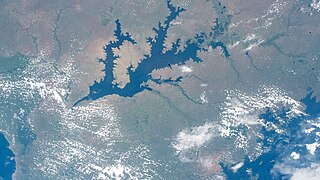
Lake Kyoga or Lake Kioga is a large shallow lake in Uganda, about 1,720 km2 (660 sq mi) in area and at an elevation of 1,033 metres. The Victoria Nile flows through the lake on its way from Lake Victoria to Lake Albert. The main inflow from Lake Victoria is regulated by the Nalubaale Power Station in Jinja. Another source of water is the Mount Elgon region on the border between Uganda and Kenya. While Lake Kyoga is part of the African Great Lakes system, it is not itself considered a great lake.
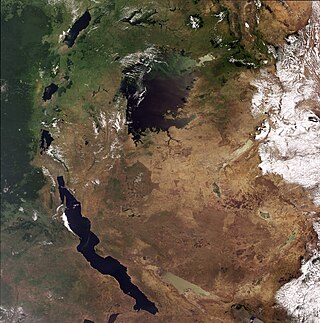
The African Great Lakes are a series of lakes constituting the part of the Rift Valley lakes in and around the East African Rift. The series includes Lake Victoria, the third-largest freshwater lake in the world by area; Lake Tanganyika, the world's second-largest freshwater lake by volume and depth; Lake Malawi, the world's eighth-largest freshwater lake by area; and Lake Turkana, the world's largest permanent desert lake and the world's largest alkaline lake. Collectively, they contain 31,000 km3 (7,400 cu mi) of water, which is more than either Lake Baikal or the North American Great Lakes. This total constitutes about 25% of the planet's unfrozen surface fresh water. The large rift lakes of Africa are the ancient home of great biodiversity, and 10% of the world's fish species live in this region.
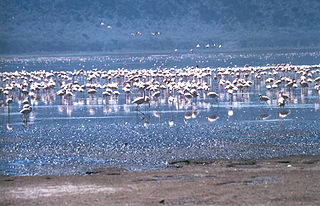
The Rift Valley lakes are a series of lakes in the East African Rift valley that runs through eastern Africa from Ethiopia in the north to Malawi in the south, and includes the African Great Lakes in the south. These include some of the world's oldest lakes, deepest lakes, largest lakes by area, and largest lakes by volume. Many are freshwater ecoregions of great biodiversity, while others are alkaline "soda lakes" supporting highly specialised organisms.

The South American lungfish, also known as the American mud-fish and scaly salamanderfish, is the single species of lungfish found in swamps and slow-moving waters of the Amazon, Paraguay, and lower Paraná River basins in South America. Notable as an obligate air-breather, it is the sole member of its family Lepidosirenidae, although some authors also place Protopterus in the family. In Brazil, it is known by the indigenous language Tupi name piramboia, which means "snake-fish", and synonyms pirarucu-bóia, traíra-bóia, and caramuru.

Protopterus is the genus of four species of lungfish found in Africa. Protopterus is considered the sole genus in the family Protopteridae, which is grouped with Lepidosiren in the order Lepidosireniformes.

The gilled lungfish, also known as the East African lungfish, is a species of African lungfish. It is found in the swamps and flood plains of East Africa, and has been positively identified in Kenya, Somalia and Mozambique. Records from Tanzania require confirmation and may be the result of introductions.

The West African lungfish, also known as the Tana lungfish or simply African lungfish, is a species of African lungfish. It is found in a wide range of freshwater habitats in West and Middle Africa, as well as the northern half of Southern Africa.
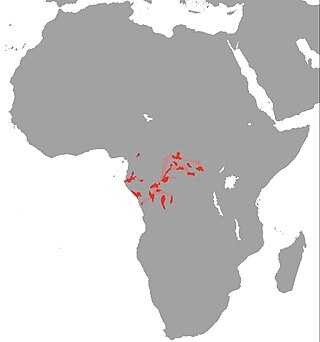
The spotted lungfish or slender lungfish is a species of lungfish from Middle Africa, where found in the Congo, Kouilou-Niari and Ogowe river basins. It is one of four extant species in the genus Protopterus.

Lake Victoria supports Africa's largest inland fishery, with the majority of the catch being the invasive Nile perch, introduced in the Lake in the 1950s.
There are two major sources of fish in Uganda; one is from aquaculture, the other from fishing in rivers and lakes. Different types of fish flourish in different water sources. The waters of Uganda contain an impressive array of fish species—over 90 in all. This count does not include the Haplochromis complex, which itself is made up of more than 200 species.

Lake Victoria supports Africa's largest inland fishery, with the majority of present catch being the invasive Nile perch, introduced to the Lake in the 1950s. Prior to the introduction of Nile perch as well as Nile tilapia, the fish community was very different and consisted mainly of 'Ngege' and Victoria tilapia as well as vast numbers of Haplochromis species. Fish communities in the first half of the 20th century are known primarily from a unique fisheries survey conducted in 1927-1928 by the Colonial Office.

Ceratodontiformes is the only extant order of lungfish, containing the families Neoceratodontidae, Lepidosirenidae, and Protopteridae as well as many other extinct groups. Members of this group are the only lungfish known to have survived the Permian-Triassic extinction event. Although lungfish originated in marine environments, the Ceratodontiformes have been an exclusively freshwater group since the Carboniferous. This order was formerly considered the suborder Ceratodontoidei.
Lake Sare is a lake in western Kenya that lies between the Yala Swamp and Lake Victoria. It has potential as a site for restocking fish species that have become endangered in Lake Victoria, but due to lack of management the lake ecology is steadily degrading.

Nile crocodiles are apex predators throughout their range. In the water, this species is an agile and rapid hunter relying on both movement and pressure sensors to catch any prey that presents itself inside or near the waterfront. Out of the water, however, the Nile crocodile can only rely on its limbs, as it gallops on solid ground, to chase prey. No matter where they attack prey, this and other crocodilians take practically all of their food by ambush, needing to grab their prey in a matter of seconds to succeed. They have an ectothermic metabolism, so can survive for long periods between meals—though when they do eat, they can eat up to half their body weight at a time. However, for such large animals, their stomachs are relatively small, not much larger than a basketball in an average-sized adult, so as a rule, they are anything but voracious eaters.




















